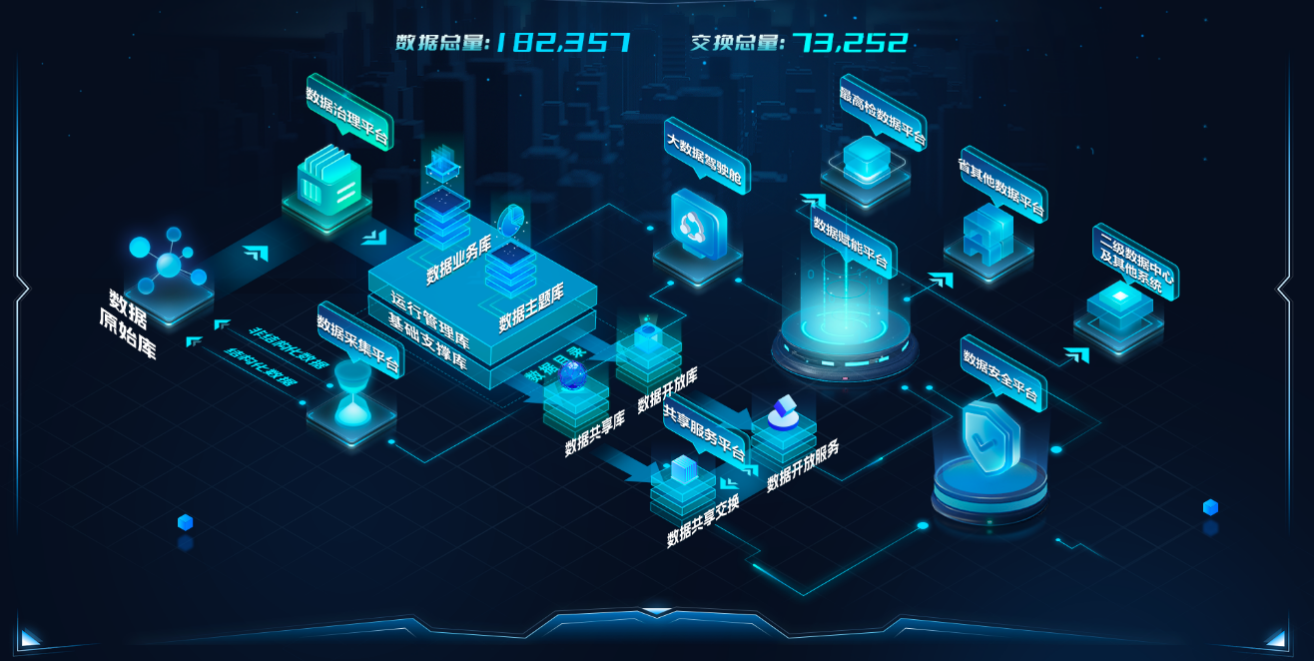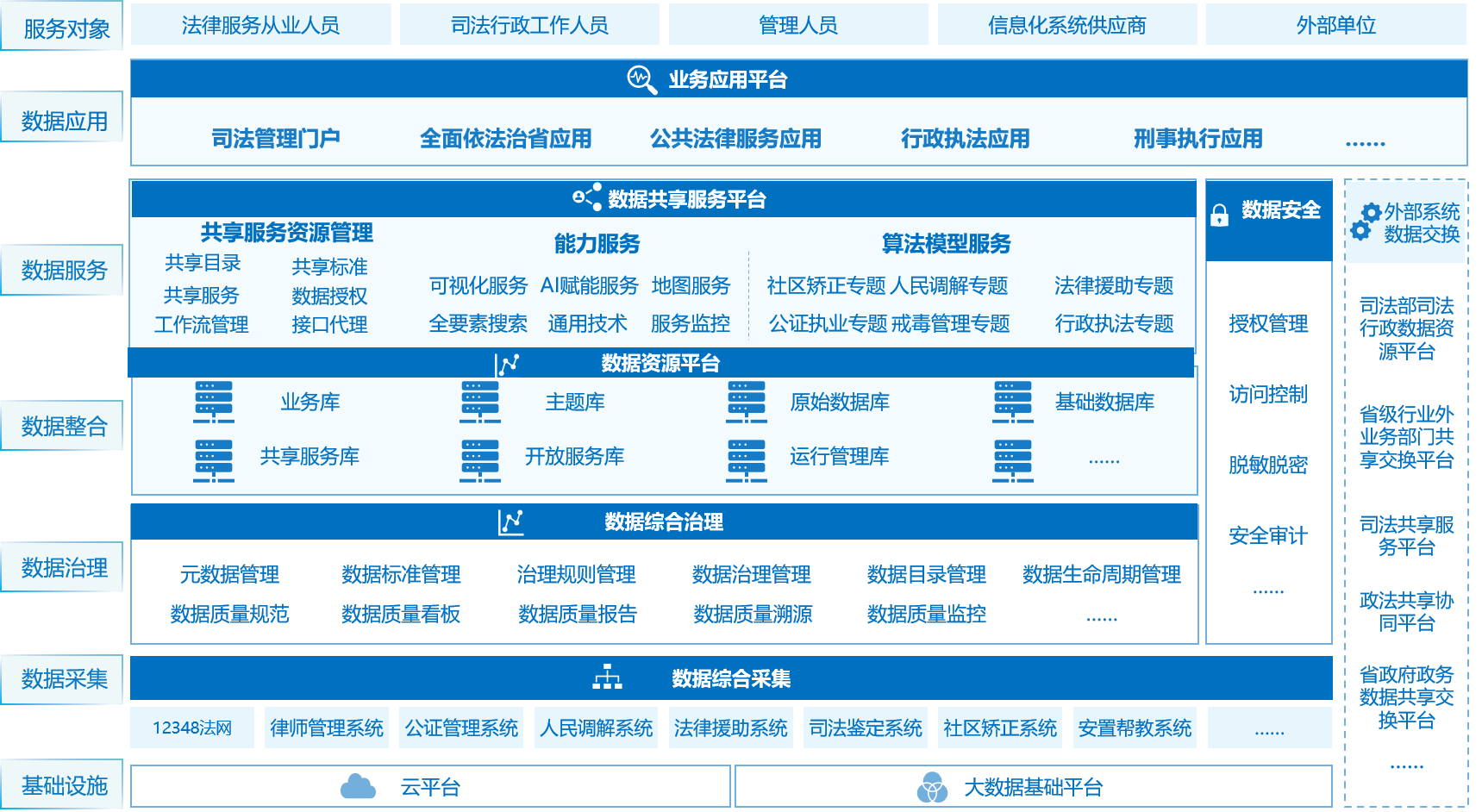

Government and Legal Departments/Units

The Beiming Judicial Data Middle Platform is anchored on the foundational pillars of "planning, governance, integration, and sharing." It meticulously catalogues, consolidates, and scrutinizes vast and multi-faceted data resources to ensure their coherence and reusability. By offering data assets, data monitoring, and data analysis services to frontline operations, the platform ultimately maximizes the value extraction from these data assets. Embracing unified data standards within the middle platform, stringent measures are taken to uphold data quality and facilitate seamless service modeling, service control, security management, and intelligent analysis engine integration across various modules. This approach enables the aggregation, governance, and application of data across domains, culminating in the provision of judicial big data service products to governmental bodies at all levels. These products foster data-driven decision-making, efficient data management practices, and a culture of continuous data-driven innovation.

1. Enhancing the standards of the Judicial Data Middle Platform by effectively managing the inflow and outflow of data
The judicial data middle platform defines the middle platform data standards to establish a robust operational framework encompassing data aggregation, governance, integration, and shared services, which helps facilitate real-time data sharing and enabling on-demand data access in the judicial sector. Being the exclusive interface for both internal and external data export from the court, the platform stands as the nucleus for constructing advanced intelligent applications and data services.
2. Creating a data graph to establish a comprehensive court data management model
This platform aggregates vast volumes of data within the judicial domain, organizing information pertinent to judges' case management and administrative systems, and structuring data trees and mapping systems such as trial proceedings and enforcement. By creating a unified data management model for the court, the aim is to categorize data based on five key information types - “people, case, location, knowledge, and information” - to normalize, standardize, and systematize data handling practices.
3. Enhancing system functionality reuse and data fusion
This platform is equipped with advanced capabilities to intelligently identify and analyze semi-structured documents, including files and judicial records, creating a centralized data fusion pool. This resource serves as a valuable data source for key business applications like case retrieval, statistical reporting, and situational analysis. Furthermore, by establishing a comprehensive one-stop data empowerment center, the platform enables the development of an agile, data-driven operational model. This initiative enhances innovative data capabilities and provides valuable feedback loops to enrich the entire judicial business landscape.


Figure: Business Flow Chart

Figure: Overall Structure

1. Establishing a Judicial Data Middle Platform with defined data standards
This platform enables a comprehensive system operation mechanism encompassing data governance, integration, and shared services, facilitates real-time data sharing and on-demand access to judicial data, and provides seamless data services to enable end-to-end intelligent solutions within the judicial sector.
2. Driving comprehensive governance and elevate data quality
The Judicial Data Middle Platform enables government and legal entities to dynamically conduct full-quantity data governance, regularly publishes data resource governance reports, and oversees the rectification of problematic data.
3. Guiding scenario-based applications to activate data resource
This platform extends to specific business contexts to address key business challenges in the judicial sector, and utilizes the Smart Court Brain as a central hub to foster innovative business and data interactions.
4. Implementing hierarchical data management to uphold data security standards
The Judicial Data Middle Platform enables government and legal entities to exercise hierarchical data control using varied protection measures and tools, ensuring orderly disclosure of judicial data in compliance with regulations.

Scenario 1: Achieving Comprehensive Judicial Data Coverage
By leveraging comprehensive retrieval and subject databases, this platform establishes a link to all business data, enabling cross-business network queries and calls. Automation through crawling mechanisms facilitates the exchange and acquisition of information data seamlessly, without the need for manual intervention.
Scenario 2: Data Association and Integration in the Judicial Domain
This platform focuses on combining various elements such as “people, case, location, knowledge, and information” within application contexts to address specific usage requirements effectively. Through advanced processing of intermediary data layers and the utilization of big data technology for in-depth analysis, this approach supports work processes, facilitates scenario integration, and actively integrates with business systems. By developing data products and application tools and embedding them as functional modules within business systems, this platform facilitates data-driven feedback loops for improved business practices.

1. Guangdong Provincial Higher People's Court Smart Court Brain and Data Middle Platform Construction Project
2. Jiangsu Provincial Higher People's Court Provincial Court Data Center Construction Project
3. Hubei Provincial Higher People's Court "Court Cloud" Big Data Management and Service Center Construction Project
4. Jiangsu Provincial Department of Justice Big Data Resources and Infrastructure Support Platform System Construction Project